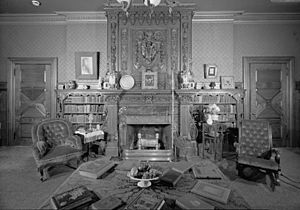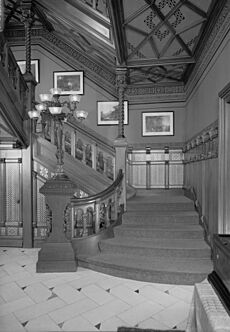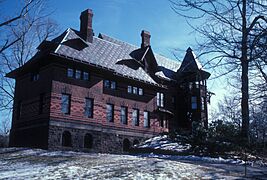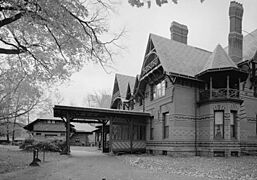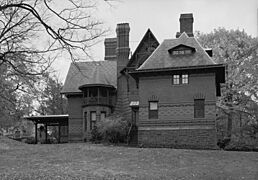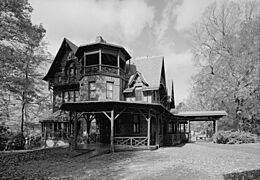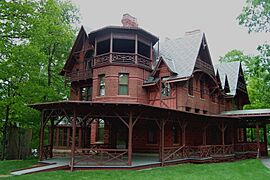Mark Twain House facts for kids
|
Mark Twain House
|
|
|
U.S. Historic district
Contributing property |
|
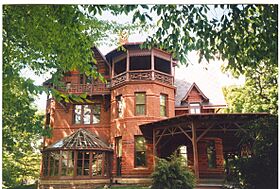 |
|
| Location | 351 Farmington Avenue, Hartford, Connecticut |
|---|---|
| Built | 1874 |
| Architect | Edward Tuckerman Potter |
| Architectural style | Victorian Gothic |
| Website | www.marktwainhouse.org |
| Part of | Nook Farm and Woodland Street District (ID79002674) |
| NRHP reference No. | 66000884 |
Quick facts for kids Significant dates |
|
| Added to NRHP | October 15, 1966 |
| Designated NHL | December 29, 1962 |
| Designated CP | November 29, 1979 |
The Mark Twain House and Museum in Hartford, Connecticut, was the home of Samuel Langhorne Clemens, also known as Mark Twain. He and his family lived here from 1874 to 1891. The Clemens family asked Edward Tuckerman Potter to design their house. It was built in a style called High Gothic. One writer described it as "part steamboat, part medieval fortress and part cuckoo clock."
Mark Twain wrote many of his most famous books while living in this house. These include The Adventures of Tom Sawyer, The Prince and the Pauper, Life on the Mississippi, Adventures of Huckleberry Finn, A Tramp Abroad, and A Connecticut Yankee in King Arthur's Court.
The Clemens family faced some tough financial times. Because of this, they moved to Europe in 1891. To help pay off their debts, Mark Twain, his wife Olivia, and their daughter Clara traveled in 1895–96. Twain gave lectures to earn money during this trip. He wrote about this journey in his book Following the Equator (1897).
Their other two daughters, Susy and Jean, stayed behind. Sadly, Susy died at home on August 18, 1896, from spinal meningitis. This happened before the family could all be together again. After this sad event, they found it too difficult to live in the house. They spent most of their remaining years living outside the United States. The family sold the house in 1903.
Over the years, the building was used as a school, an apartment building, and even a public library. In 1929, a group called the Mark Twain Memorial saved it from being torn down. They turned it into a non-profit organization. The building was named a National Historic Landmark in 1962. After a lot of work to restore it, the house opened as a museum in 1974. In 2003, a new visitors' center was built. It has a museum that shows Mark Twain's life and his amazing work.
The museum faced financial challenges around 2008. This was partly because building the new visitors' center cost more than expected. But many people helped the museum. The state of Connecticut, different companies, and other donors gave money. Writers even organized a special show to raise funds. Since then, the museum's financial situation has improved.
In 2012, the museum had a record number of visitors. It has hosted famous writers like Stephen King, Judy Blume, and John Grisham. The museum also has writing programs and gives out awards. In the same year, the Mark Twain House was named one of the "Ten Best Historic Homes in the world" by National Geographic Books.
Contents
Mark Twain's Move to Hartford
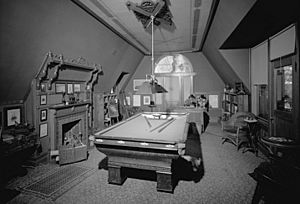
Mark Twain first visited Hartford in 1868. He was working on his book The Innocents Abroad with a publisher there. Hartford was a big center for publishing books at that time. After marrying Olivia Langdon, Twain moved to a large home in Buffalo, New York. However, he soon thought about moving to a grander house in Hartford. He wanted to be closer to his publisher.
The family first rented a house in an area called Nook Farm in 1871. Later, they bought land there and built their new home. Mark Twain loved Hartford. He said, "Of all the beautiful towns it has been my fortune to see, this is the chief…. You do not know what beauty is if you have not been here." He was also drawn to the city because it had the highest income per person in the United States back then.
Designing and Building the House
The house was designed by Edward Tuckerman Potter, an architect from New York City. While it was being built, a local newspaper, the Hartford Daily Times, wrote about it. They said the house's unique design and its famous owner would make it well-known for a long time. Mrs. Clemens' family money paid for the cost of building the house.
The home is built in the Victorian Gothic Revival style. This style often includes a roof with steep slopes and windows that are not placed evenly. Some people say the house was designed to look like a riverboat. Another style it shows is the Stick style of Victorian architecture.
In 1881, the family bought more land next to their property. They changed the landscaping and updated the house. The driveway was moved, the kitchen was rebuilt and made twice as big, and the front hall was made larger. They also put in new plumbing, heating, and a burglar alarm. After these updates, the house cost about $70,000 in total. The furnishings cost $22,000, and the land itself was $31,000.
Life Inside the Mark Twain House
The Clemens family moved into their finished home in 1874. The top floor had a billiards room and Mark Twain's private study. He would write there late at night. This room was usually off-limits to everyone except the cleaning staff. It was also a place where he would entertain male guests with cigars and drinks. Twain once joked, "There ought to be a room in this house to swear in. It's dangerous to have to repress an emotion like that."
The children had their own special area. This included a nursery and a playroom that also served as a classroom. Mrs. Clemens taught her daughters in a large school room on the second floor. Mark Twain loved playing with his children in the conservatory. He would pretend to be an elephant on an imaginary safari. He felt a deep connection to the house, saying it "was of us, and we were in its confidence and lived in its grace and in the peace of its benediction."
Mark Twain enjoyed living in the house partly because he knew many other writers in his Hartford neighborhood. Harriet Beecher Stowe, who wrote Uncle Tom's Cabin, lived right next door. Isabella Beecher Hooker was also a neighbor. Twain also welcomed many authors as guests, such as Thomas Bailey Aldrich and William Dean Howells. Famous actors like Henry Irving and Edwin Booth also visited.
Twain wrote many of his most famous books in this home. These include The Adventures of Tom Sawyer (1876) and Life on the Mississippi (1883). The success of The Adventures of Tom Sawyer inspired him to update the house. In 1881, he had Louis Comfort Tiffany oversee the interior decoration. Twain was also very interested in new inventions. He had one of the first telephones installed in his home.
Mark Twain invested a lot of money in a new typesetting machine. He also started a publishing company called Charles L. Webster & Company. This company published Twain's own books and a very popular book by Ulysses S. Grant. The company's first book was Adventures of Huckleberry Finn in 1884. However, the company went out of business in 1894. This left Twain with a lot of debt. The typesetting machine he invested in never worked well. It was also beaten by a better machine called the linotype machine.
The money lost from these investments, along with some financial problems across the country, led the Clemens family to move to Europe in 1891. Living in Europe was more affordable. Twain began giving lectures across Europe to earn money for his family. He could not afford to live in the house anymore, so he rented it out. He only returned once in 1895. He wrote, "As soon as I entered this front door I was seized with a furious desire to have us all in this house again & right away, & never go outside the grounds any more forever. . . It is the loveliest home that ever was.”
After the Twain Family Left
Katharine Seymour Day, a relative of Harriet Beecher Stowe, knew the Clemens family. She saved the Twain House from being destroyed in 1929. She started an organization called Friends of Hartford. This group raised $100,000 to get a loan for the home. The house was carefully restored between 1955 and 1974. It took many years to pay off the loan and raise money to fix the old building. They also worked to find and bring back original furniture and personal items. The whole process finished in 1974, just in time for the house's 100th anniversary. It also won an award in 1977 for its "exemplary restoration."
You can visit the Mark Twain House by taking a guided tour. These tours focus on different themes about the house and Twain's life. The House and Museum also offer many events. These include talks, writing workshops, and family activities.
Restoring the House
The house had a big renovation starting in 1999. This included work on the outside wood, tiles, and brick. They also rebuilt the purple slate roofs. The goal was to make the house and its grounds look just like they did between 1881 and 1891. This was the time when the Clemens family loved the house the most. The marble floor in the front hallway was carefully restored. Experts also repainted the walls and ceilings and fixed the woodwork. This brought back the beautiful designs that Louis Comfort Tiffany had created.
The restoration work received money from grants. Computers were also used to help with the restoration. In 2016, a part of the house called the Mahogany Suite was fully restored. This included fixing the wood and plaster, and putting back the old wallpapers. Today, the home has 50,000 items. These include old writings, photos, family furniture, and Tiffany glass. Many of the original furnishings are still there. This includes the Clemens' fancy Venetian bed, a beautifully carved fireplace mantel from a Scottish Castle, and a billiard table.
Financial Challenges and Recovery
The number of visitors to the house stayed around 53,000 each year. The people in charge of the house decided they needed to grow or they would have to make their operations smaller. They hired Robert A. M. Stern to design a visitors' center. This center was planned so it would not take attention away from the historic house itself.
The Education and Visitors Center was built next to the Carriage House. This is where the Clemens family's coachman and his family once lived. This new building was the first museum in America to get a special "green building" certification. This means it was built in a way that is good for the environment. The center is a large facility that holds many items from the museum's collection that are not shown in the house. It also has a lecture hall and classrooms. The house received $1 million from the state government to help with the costs of building the museum and restoring the house. Since the museum opened in November 2003, more people have visited.
In 2000, the house brought in $5 million from tourism with 50,000 visitors. Different groups and foundations also gave money to help the house. After building the Visitors Center in 2003, the house faced financial difficulties. It started a campaign to raise awareness and money. The state government, the governor, and many companies and people helped. By 2011, museum officials said that it had recovered financially.
In 2011, a writer named Steve Courtney published a book about the house's history and its restoration. The book includes a special introduction by Hal Holbrook, who is a trustee of the house.
Gallery
See also
 In Spanish: Casa de Mark Twain para niños
In Spanish: Casa de Mark Twain para niños
- Stormfield
- List of National Historic Landmarks in Connecticut
- List of residences of American writers
- National Register of Historic Places listings in Hartford, Connecticut
- North American Reciprocal Museums


